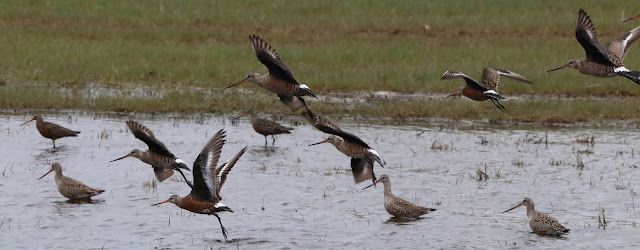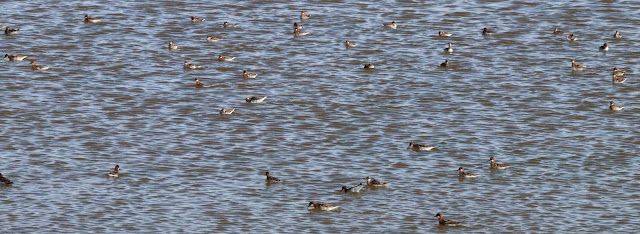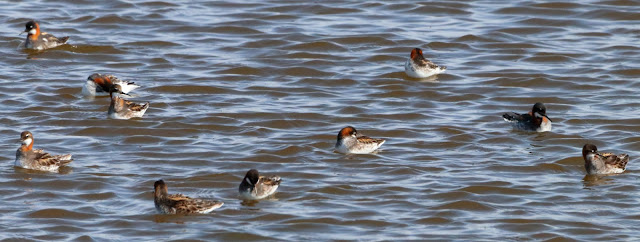I found my first godwits of the trip near Berea, North Dakota, on 24 May--day three of my Big Trip. These were migrants headed to their northern breeding habitat in Alaska or Canada (where I was headed)...
Across the Continent, Part 1 (of 10):
Bethesda, Maryland to Whitecourt, Alberta
22-26 May 2022
Getting to godwit breeding habitat by car involves lots of driving across vast stretches of flat open country...
In 2016, I did a big solo driving field trip from Texas to northern Ontario, following the migration of the wood warblers. I spent 100 days camped in the field, visiting the breeding grounds of all 37 species of warblers that inhabit central and eastern North America. That trip was chronicled in the book entitled North on the Wing--Travels with the Songbird Migration of Spring.
Packing the car is an art. The car served as my home for more than a month... see how spiffy the car is this day. In later
blogs you will see a car with an entirely different look.
In 2018, I decided to do a similar field trip that followed the migration of our shorebirds (called waders in the UK)--the sandpipers, curlews, and godwits, which are stupendous travelers, even more accomplished than the wood warblers. I decided to focus mainly on the Hudsonian Godwit. This large, colorful, and rarely-seen shorebird would be my flagship species for the Project.
Eastern Kingbirds are widespread from the East Coast into the plains of northwestern North America.
The first night of my drive I spent in a Motel 8 in Fargo, North Dakota. Here a thunderstorm approached...
I did the first three trips in 2019 and 2020. The fourth and most complex trip was held up by my inability to cross the Canadian border because of covid-19. That final big trip I report on now...if you want to reprise my earlier godwit trips, they are reported in earlier editions of my Blog--feel free to go back and read them... I should also note that I did a US-only trip in spring 2021, after I had to postpone my big road trip into northern Canada and Alaska. The 2021 trip sought to spend more time with godwits in the north-central US on their spring migration northward.
American Wigeons are common and widespread across North America. I saw them on many occasions...
I am planning 10 blogs, issued through the month of July. In these, I will detail (1) my drive from Bethesda, Maryland, to Anchorage, Alaska. (2) visits (by air) to Nome, AK, and Utqiagvik (Pt Barrow), AK. (3) My drive from Anchorage across the "Top of the World" to the Yukon, and then northward in Canada on the Dempster Highway to the Arctic Ocean and the tiny indigenous community of Tuktoyaktuk, Northwest Territories--as far north as one can drive in mainland Canada. (4) And finally my drive home to Bethesda, Maryland--logging more 11,834 miles by car, all told, over 43 days.
Traveling long distances the first week, I saw mainly common bird species, like this American Robin.
Day One, 22 May 2022, I drove 676 miles, ending in Urbana, Illinois, passing through six states. I departed my home at 0607am and arrived at my motel at 6:15pm. I stopped for breakfast in Uniontown, PA, and for lunch in Vandalia, Ohio. The first seven days, with some minor excepts was "drive and sleep"--hoping to see the occasional interesting bird or mammal from the windows of the speeding car.
In the dry midwest of the US, the Red-headed Woodpecker is a common resident--one of the most beautiful of woodpeckers.
Saw this species is Indiana. It was the bird of the day, no doubt.
After settling into my motel in Urbana, I drove out into the rural countryside, to Sellers, Illinois, for a late afternoon bird walk. Featured birds were Dickcissel, Chipping Sparrow, Song Sparrow, and House Wren. I had dinner at a Mexican restaurant of indifferent quality and hit the sack early.
After Hudsonian Godwit and Marbled Godwit, Baird's Sandpiper was the best bird of the trip's first week (seen near
Saskatoon, SK).
This morning in Illinois I saw a roadside sign that states "GunsSaveLife.com"... and a sign I saw the day before in Indiana stated: "Jesus is Alive. Go to Truth.com." Clearly, I am solidly in the Heartland. I see lots of planted cornfields, as well as the white blossoms of blooming locust trees along the Illinois River. North of Madison, Wisconsin, I start seeing White Pines (hint of boreal forest to come), and also some planted Red Pine, and those scruffy Jack Pines, which is a true boreal species (which loves fire). Highlight of the day is seeing the limestone buttes that tower by the road in the Wisconsin Dells. I saw Trumpeter Swan pairs in western Minnesota.
If you hit the Prairie Potholes at the right time, you can find large flocks of Red-necked Phalaropes, which typically are
difficult to find except out on the open ocean or in the Far North.
Day Two ended at Fargo, North Dakota, after more than 13 hours at the wheel and 743 miles of driving. Temps were in the 60s all day. My route to Anchorage, by the way, goes as follows: MD-PA-WV-OH-IN-IL-WI-MN-ND-SK-AB-BC-YU-AK.
Red-necked Phalaropes, on migration to their breeding grounds in northern Canada and Alaska.
Road kill: in the first two days I saw lots of dead deer, raccoons, and skunks. Got caught in the Minneapolis PM rush, which ain't fun... Day Three I detoured out to a wetland near Berea, North Dakota (just west of Valley City), where Hudsonian Godwits had been reported. I always get a rush when I see these bird handsome shorebirds standing in shallow water off in the distance. This is always a special bird for birders. There were eight of them, mainly males in breeding plumage. I was in high prairie and Horned Larks were displaying in the cool morning air and Yellow-headed Blackbird males were making their terrific noise as they parachuted high over their reedy territories.
Marbled Godwit
Saskatchewan scenery....
On Day Four I drove from Moose Jaw to Whitecourt, Alberta. Both Saskatchewan and Alberta are new provinces for my North American list of states and provinces...
I saw my first bear (a Black Bear) on the morning of the 26th May in northwestern Alberta. I also saw Mule Deer, the western counterpart to our eastern White-tail. A taste of things to come...
Velva, North Dakota, is home to Dot's Pretzels, but otherwise a pretty small western town.
North Dakota is one of my very favorite states. The tilled earth here is blackish and rich-looking. It is great birding country because of the Prairie Potholes. This day I saw pairs of Western Grebes--lanky and graceful... I was surprised to see Eurasian Collared-Dove in the small towns...
Western Kingbird is common across the Great Plains of the US.
On Day Three, after my birding side-trip, I drove from Fargo northwestward to Moose Jaw, Saskatchewan. I was happy to depart from my dirty and noisy Motel 6 to be out on the clean road... This is little-populated and wide-open prairie country and it is great driving territory. The standard interstate speed limit in North Dakota is 75 mph. I drive 534 miles, arriving in Makamow Campground in Moose Jaw town at 5:30pm. It was sunny and 70F. Best birds of the day were Marbled Godwits--larger cousins to the Hudsonian. The Marbled mainly nest in the Prairie Pothole country of Canada and the northern US. I also see Stilt Sandpipers and Upland Sandpipers. Quality birds!
I love driving through the wide-open plains and prairies--the sky goes forever and it is such a change from what I know back on the East Coast. A different world.
I cross over into Canada at North Portal, SK, and get chided by the border staff for not mentioning the machete in my cook box. They let me keep it... Canadians are nice! I passed by the low Cactus Hills and Dirt Hills. The night in Moose Jaw was filled with the rumble and screech of passing freight trains
--taking me back to the 1950s (I grew up next to the Ma & Pa Rail Line in Baltimore)...
I drove 573 miles through northern prairie land, looking for signs of the boreal forest to come. Prairie dominated. I saw few birds, just common species such as Brewer's Blackbird (above).
And Alberta is oil and gas (and tar sands) country. There was lots of evidence of petroleum extraction along the way (above).
And more wide-open land with not much on it.
Though there were signs of substantial agricultural productivity in the towns I passed (photo above).
The Lions Club Campground in Whitecourt, Alberta, with the first boggy stands of White Spruce....
As I approached Whitecourt, I was entering forest land dominated by boreal spruce. Whitecourt featured oil, pulp, and timber industries.... The evening at the campground in Whitecourt I saw my first mosquitoes of the trip (but not the last). It cooled down quickly and reminded me of the Adirondacks.
Part 2 of the Blog series will feature northern British Columbia, which offers quite a change from the prairie lands I had been driving across the last several days. So reaching northwestern Alberta, I had done a lot of the heavy lifting in terms of thankless driving. Parts 2 and onward will feature a world of snow-capped mountains and wildlife. And it will get better and better and stranger and stranger.... Stand by for the upcoming blogs!






















No comments:
Post a Comment